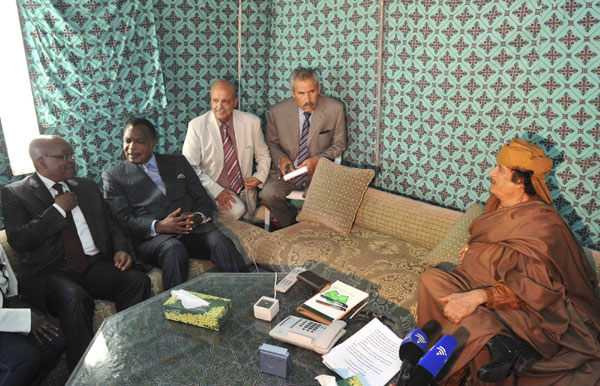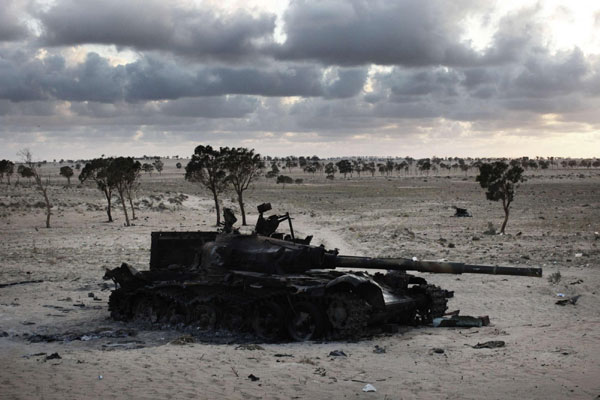Global General
African Union says Libya accepts cease-fire plan
(Agencies)
Updated: 2011-04-11 08:30
 |
Large Medium Small |
|
 South Africa's President Jacob Zuma (L) talks to Libya's leader Muammar Gadhafi (R) and Congo Republic's President Denis Sassou Nguesso (2nd L) upon their arrival in Tripoli, in this handout picture by South Africa's Government Communications and Information service (GCIS) April 10, 2011.[Photo/Agencies] |
The terms of the African Union's road map were unclear _ such as whether it would require Gadhafi to pull his troops out of cities as rebels have demanded.
"We have completed our mission with the brother leader, and the brother leader's delegation has accepted the road map as presented by us," said South African President Jacob Zuma. He traveled to Tripoli with the heads of Mali and Mauritania to meet with Gadhafi, whose more than 40-year rule has been threatened by the uprising that began nearly two months ago.
"We will be proceeding tomorrow to meet the other party to talk to everybody and present a political solution," Zuma said, speaking at Gadhafi's private Tripoli compound, Bab al-Aziziya. He called on NATO to end airstrikes to "give the cease-fire a chance."
Gadhafi enjoys substantial support from countries of the AU, an organization that he chaired two years ago and helped transform using Libya's oil wealth. So it is not clear whether rebels would accept the AU as a fair broker.
Though the AU has condemned attacks on civilians, last week its current leader, Equatorial Guinea President Teodoro Obiang Nguema, decried foreign intervention in Libya's nearly two-month-old uprising, which he declared to be an internal problem.
An official from the African bloc, Khellaf Brahan, said previously that its proposals call for an immediate cease-fire, opening channels for humanitarian aid and talks between the rebels and the government.
Through the rebels have improved discipline and organization, they remain a far less powerful force than Gadhafi's troops. Members of the international community have grown doubtful that the opposition can overthrow Gadhafi even with air support, and some are weighing o Idris, the supervisor of a hospital in the city. A total of 38 people were killed in fighting over the weekend, including 11 rebels and seven civilians, Idris said.
The main front line in Libya's uprising runs along a 600-mile (1,000-kilometer) coastal highway from Benghazi, Libya's second-largest city, to Tripoli, the capital, where Gadhafi's power is concentrated. Rebels have been pushed back on two previous advances toward Tripoli, both times as they approached the heavily fortified Gadhafi stronghold of Sirte.
Over the past few days, Gadhafi's forces have been knocking the rebels back eastward in their most sustained offensive since international airstrikes drov carrying large rocket launchers.
However, sporadic shelling could still be heard around western Ajdabiya late in the afternoon.
A body brought to the morgue, said to be a rebel fighter shot near Ajdabiya's west gate, had his hands and feet bound. Another body was an Algerian who had been fighting for Gadhafi, Dr. Suleiman Rafathi said at the hospital. He said the man's ID confirmed his origin, but that rebels took the ID before an Associated Press reporter arrived. Rebels have said many Gadhafi fighters are foreign mercenaries.
Another Gadhafi fighter, about 20 years old, was on a ventilator _ brain-dead but with a beating heart, Rafathi said.
Rebel fighter Sami Kabdi said the young man had been firing out a window of a school. When rebels told him to surrender, he put the muzzle of his AK-47 under his chin and fired, Kabdi and Rafathi said.
Rebels had been growing critical of NATO, which accidentally hit opposition fighters in deadly airstrikes twice this month. They have complained that the alliance was too slow and imprecise, but Hassy, the rebel commander, said it is getting better.
"To tell you the truth, at first NATO was paralyzed but now they have better movement and are improving," he said.
The commander of the NATO operation, Canadian Lt. Gen. Charles Bouchard, stressed in a NATO statement that the point of the airstrikes was to protect civilians, not to work hand-in-hand with the rebels.
"The situation in Ajdabiya, and Misrata in particular, is desperate for those Libyans who are being brutally shelled dhafi's heavy weapons, but the rebels have managed to hold out.
In Tripoli, Libya's deputy foreign minister accused NATO of a double standard on the no-fly zone, claiming that government forces shot down two US-built Chinook helicopters being used by rebel forces in the east of the country.
"We have a question for the allied forces _ is this resolution made for the Libyan government only or everyone in Libya?" he asked.
The report could not be confirmed with the rebels, but journalists in the area did describe seeing at least one helicopter apparently fighting for the rebels in the area Saturday, though it lacked the distinctive double rotor design of the Chinook and appeared to be a Russian-built model.
|
 A Libyan government tank destroyed by Western air strikes sits beside the coastal highway near Ajdabiyah in eastern Libya, March 31, 2011. [Photo/Agencies] |
| 分享按钮 |